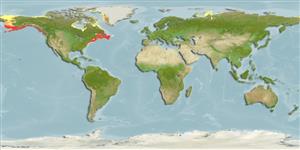Echinoidea |
Echinolampadacea |
Echinarachniidae
Environment: milieu / climate zone / تغييرات عمق / distribution range
بوم شناسي
; تغييرات عمق 0 - 150 m (مرجع 95072). Polar
Arctic, Northern Pacific and Northern Atlantic. Polar to subtropical.
Length at first maturity / Size / Weight / سن
بلوغ: Lm ? range ? - ? cm
Life cycle and mating behavior
بلوغ | تولید مثل | تخم ریزی | Eggs | Fecundity | Larvae
Members of the class Echinoidea are gonochoric. Fertilization is external. Brooding is common, eggs are held either on the peristome, around the periproct or deep into the concavities on the petaloids. Life cycle: Embryos develop into planktotrophic larvae (echinoplateus) and live for several months before they sink to the bottom using their tube feet to adhere on the ground where they metamorphose into young urchins.
مآخذ اصلی
مراجع | هماهنگ كننده | همكاران
Austin, W.C. 1999 Rare and endangered marine invertebrates in British Columbia. Proc. Biology and Management of Species and Habitats at Risk, Kamloops, B. C., 15-19, Feb 1999. (مرجع 1306)
وضعيت در فهرست قرمز IUCN
(مرجع 130435: Version 2025-1)
وضعيت از نظر سايتس (مرجع 108899)
Not Evaluated
Not Evaluated
خطر برای انسان ها
استفاده انسانی
| FishSource |
ابزارها
اطلاعات بيشتر
Trophic EcologyFood items (preys)تركيب غذاييمصرف غذاييشکارچیان Population dynamicsرشدMax. ages / sizesLength-weight rel.Length-length rel.نوسانات طولیMass conversionفراواني Life cycleتولید مثلبلوغFecundityتخم ریزیEggsنمو تخمLarvae PhysiologyOxygen consumption
Human RelatedStamps, coins, misc.
منابع اينترنتي
Estimates based on models
Preferred temperature
(Ref.
115969): 1.5 - 11.5, mean 5.4 (based on 800 cells).
طبقه قيمت
Unknown.
